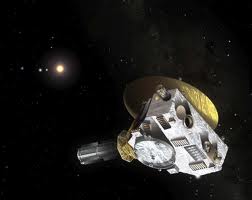
 SIGNS CHANGING FAST FOR VOYAGER AT SOLAR SYSTEM EDGE — Two of three key signs of changes expected to occur at the boundary of interstellar space have changed faster than at any other time in the last seven years, according to new data from NASA’s Voyager 1 spacecraft.
SIGNS CHANGING FAST FOR VOYAGER AT SOLAR SYSTEM EDGE — Two of three key signs of changes expected to occur at the boundary of interstellar space have changed faster than at any other time in the last seven years, according to new data from NASA’s Voyager 1 spacecraft.
For the past seven years, Voyager 1 has been exploring the outer layer of the bubble of charged particles the Sun blows around itself. In one day, on July 28, data from Voyager 1’s cosmic ray instrument showed the level of high-energy cosmic rays originating from outside our solar system jumped by five percent. During the last half of that same day, the level of lower-energy particles originating from inside our solar system dropped by half. However, in three days, the levels had recovered to near their previous levels.
A third key sign is the direction of the magnetic field, and scientists are eagerly analyzing the data to see whether that has, indeed, changed direction. Scientists expect that all three of these signs will have changed when Voyager 1 has crossed into interstellar space. A preliminary analysis of the latest magnetic field data is expected to be available in the next month.
“These are thrilling times for the Voyager team as we try to understand the quickening pace of changes as Voyager 1 approaches the edge of interstellar space,” said Edward Stone, the Voyager project scientist based at the California Institute of Technology, Pasadena, Calif. “We are certainly in a new region at the edge of the solar system where things are changing rapidly. But we are not yet able to say that Voyager 1 has entered interstellar space.”
The levels of high-energy cosmic ray particles have been increasing for years, but more slowly than they are now. The last jump—of five percent—took one week in May. The levels of lower-energy particles from inside our solar system have been slowly decreasing for the last two years. Scientists expect that the lower-energy particles will drop close to zero when Voyager 1 finally crosses into interstellar space.
“The increase and the decrease are sharper than we’ve seen before, but that’s also what we said about the May data,” Stone said. “The data are changing in ways that we didn’t expect, but Voyager has always surprised us with new discoveries.”
Voyager 1, which launched on Sept. 5, 1977, is 11 billion miles from the Sun. Voyager 2, which launched on Aug. 20, 1977, is close behind, at 9.3 billion miles from the Sun.
************
 MEANWHILE, A LOT CLOSER TO HOME but still very far out, NASA’s New Horizons spacecraft is alive and well and has gone about 2/3 of the way on its long journey to Pluto and beyond.
MEANWHILE, A LOT CLOSER TO HOME but still very far out, NASA’s New Horizons spacecraft is alive and well and has gone about 2/3 of the way on its long journey to Pluto and beyond.
New Horizons was launched in January, 2006, directly into an Earth-and-solar-escape trajectory with an Earth-relative velocity of about 36,000 mph. Thus, the spacecraft left Earth at the greatest-ever launch speed for a man-made object. It flew by the orbit of Mars in April, 2006, the orbit of Jupiter in February, 2007, the orbit of Saturn in June, 2008, and the orbit of Uranus in March, 2011. Currently, it is roughly two billion miles from Earth and a billion miles from Pluto. Its estimated arrival date at the Pluto-Charon system is July 14, 2015.


Be the first to comment